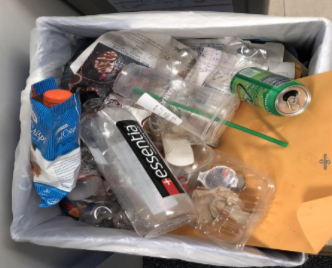Blue bin or grey bin? The recycling dilemma
February 22, 2018
Our country is getting an F in recycling. In any given city, recyclable materials are put in the wrong waste bin on a daily basis. The lack of accurate recycling contributes to the United States’ weak 34 percent recycling rate. This is a pretty dismal showing compared to the rest of the world; Germany has just hit 66 percent recycling rate, which means they are reusing or re-purposing more than half of what their citizens throw away.
Recycling is a very easy and effective way to help the planet. Landfills take up a lot of space, while also releasing harmful chemicals and greenhouse gases. These greenhouse gases contribute to the increasing temperature of our globe, which has been proven to increase extinction rates of animals and plants. By recycling you are choosing to redirect your waste; it gives trash a second life and also reduces landfills, where recyclable material can take over 500 years to break down.
Look at the images below: can you tell which University bin is recycling and which one is trash?
The one on the top is trash and the one on the bottom is recycling. When it is hard to tell which bin is which, you know our campus has a problem.
So what can you do to help?
First you should understand the five R’s: refuse, reduce, reuse, recycle, and respect. I know you are used to only three R’s but these additional pieces are arguably the most important waste reduction tips out there! This is the order of greatest impact one person can have.
Let’s use a plastic clamshell from the Bison as an example to walk through the 5 R’s. Ideally, you would simply refuse the plastic being sold and bring your own reusable container from home; however, if you are unable to do that try to reduce the amount of times you buy a meal that has a clamshell casing. Wherever possible, just say it is for here, not to go. If you can’t help but get the sandwich in a clamshell you should attempt to repurpose or reuse this clamshell multiple times. Bring it home with you, wash it, then use it for your salad the next day. You could also use it as a storage bin in your dorm!
Lastly, when you have exhausted all of the above options, put the clamshell in the recycling. This action has everything to do with the fifth R, respect. It is important to use the correct bin when discarding your waste. If you have respect for your planet and the impact you have on it, the least you can do is throw it in the blue bin. With these five R’s, you are single-handedly able to reduce your output of waste and ensure that you have a smaller impact on the planet.
To successfully be respectful when discarding of your trash, you must understand single-stream recycling (the recycling system we use at the University). For this system you should put all hard plastics into this bin, meaning your forks, spoons, knives, clamshells, and water bottles should not go in the trash. You should not put any food remains in the recycling bin, so make sure you scrape all of the food out of your plastic container before putting it into the recycling bin. Remember that with education and action, you can help prevent plastic from sitting in a landfill for 500 years.






















